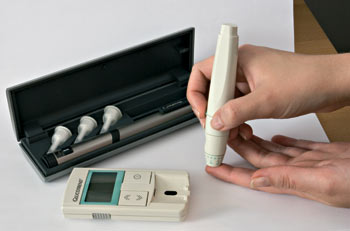Control freak
People suffering from type 1 diabetes mellitus, that is insulin-dependent diabetes, are forced to follow a very rigorous daily routine of blood tests and injections. However, it does not prevent them from leading a perfectly normal professional and private life.

Diabetes mellitus is a chronic metabolic disorder. Type 1
diabetes is caused by a shortage or a complete lack of the
insulin-producing beta cells in the pancreas. Insulin is a hormone
causing liver and muscle cells to take in glucose – a carbohydrate
furnishing them with energy. If the insulin levels are too low,
glucose, instead of being absorbed by the cells, remains in the
bloodstream, causing hyperglycemia (high blood sugar).
The disease is a genetically determined one. It can manifest itself
both in infancy, in adolescence, or in adulthood. It can be
triggered by an illness, especially a viral one, such as mumps or
rubella, or by a strong stress, but sometimes its symptoms appear
without any apparent reason. People suffering from type 1 diabetes
must constantly control their insulin levels to prevent
hyperglycemia (high blood sugar) or hypoglycemia (low blood sugar),
which can result in an impairment of brain function, loss of
consciousness or even coma.
Living with diabetes:
- Diabetes is not contagious, so people affected by it pose
no threat for their family members, friends or the people they work
with – explains dr Mirosława Gałecka, an internal medicine
specialist and a coordinator of the „Zdrowe Nogi” programme whose
aim is to prevent diabetes complications. - Diabetics must follow a
strict daily schedule of blood tests and insulin injections. As
they are well aware that their condition is permanent, with the
course of time they learn to live with it and those troublesome
procedures become an integral part of their existence and stop
being a hindrance.
Where diabetics CANNOT work:
Diabetics must not hold posts which would make them responsible for
other people's lives, e.g. bus driver, airline pilot etc. They also
must not work at heights. They cannot be expected to work in shifts
– they must not be forced to work at night.
Diabetic's rituals:
Blood tests – made everyday, sometimes even every several hours
(especially in the case of type 1). Modern glucose meters, being
extremely handy and easy to operate, make the whole process much
simpler. A drop of blood is placed on a test strip which is next
inserted into the device. The result is available within
seconds.
- The whole operation requires only a single drop of blood.
Patient's fingertip is first disinfected and then pricked with a
sterile needle. The test takes only about a minute and can easily
be performed in work hours, in the restroom, without neglecting
one's duties - explains dr Gałecka. - Each insulin injection should
be proceeded by a blood test, although diabetics, after years of
„practice”, learn to estimate their insulin levels on the basis of
their physical condition and appetite. Thus, they are able to
decide whether they need the injection or not, without the use of a
glucose meter.
People who had no prior contact with a diabetic usually imagine the
insulin injection procedure as something very painful and
stressful, associating it with a doctor's coat and a big syringe.
Meanwhile...
- Diabetics leading an active life are trying hard to make things easier for themselves. - states dr Gałecka – People who require an intensive insulin therapy perform one or two insulin injections during an eight-hour working day. Thanks to a device called insulin pen – an injecting system in the shape of a pen – the injection is much easier and does not cause discomfort to the patient and the people around him or her. However, it is advisable to make a separate room available to an employee with diabetes where he or she can perform the injections in private. Insulin pumps are even more convenient. The device, no bigger than a pager, administers insulin automatically, according to a pre-set pattern.
The daily dose of insulin depends on the amount of carbohydrates contained in the meals that a diabetic consumes during the day. Diabetics usually eat 5-6 times a day, plus they must have a meal after every injection. - explains dr Gałecka – But it does not necessarily have to be a big and wholesome meal; a sandwich, an apple or a candy bar will do. It is also true that taking exercise helps to control insulin levels, although an excessive physical exertion may lead to a sudden increase or decrease of blood sugar level. The best, and the safest way to keep fit is to take a one-hour walk every day. Should a diabetic decide to take up sport, he or she ought to consult a doctor first.
Hazards:
The greatest danger facing a diabetic at work is hypoglycemia, that
is a low level of glucose in the blood. Healthy individuals can
also suffer from hypoglycemia, especially if they didn't have a
meal at a regular time or follow a starvation diet.
- Hypoglycemia sometimes affects workers performing
physically strenuous tasks in factories. - reminds dr Gałecka – As
for diabetics, there are several external factors which may cause a
sudden fall in glucose levels, the most prominent of which are
stress and alcohol. In the former case the effects can be
instantaneous: sweating, feeling of anxiety, accelerated heartbeat,
spots before his or her eyes, trembling hands, headache. The person
may feel faint or even loose consciousness. The effects of drinking
alcohol may not show until the next day. A diabetic, who has had a
few glasses of dry vine the previous evening, wakes up the next day
in excellent condition, goes to work, eats breakfast, and after a
couple of hours starts to feel bad. In such case, give the diabetic
a sugar lump or a candy and call the doctor.
Other types of diabetes:
- Type 2 diabetes mellitus (adult-onset diabetes, non-insulin-dependent diabetes) – due to a combination of defective insulin secretion and insulin resistance or reduced insulin sensitivity
- Gestational diabetes (GDM) – occurs during pregnancy and usually resolves with delivery.
- Derivative diabetes – triggered by some medical conditions (e.g. hyperthyroidism - an „overactive thyroid gland”), genetic-related metabolic disorders, diseases of pancreas or some chemicals or drugs.
- Malnutrition-related diabetes – due to malnutrition and hunger.
***
Artykuł powstał w ramach projektu "Integracja
- Praca. Wydawnicza kampania informacyjno-promocyjna"
współfinansowanego z Europejskiego Funduszu Społecznego w ramach
Sektorowego Programu Operacyjnego Rozwój Zasobów Ludzkich.
Polecamy
Co nowego
- Ostatni moment na wybór Sportowca Roku w #Guttmanny2024
- „Chciałbym, żeby pamięć o Piotrze Pawłowskim trwała i żeby był pamiętany jako bohater”. Prezydent wręczył nagrodę Wojciechowi Kowalczykowi
- Jak można zdobyć „Integrację”?
- Poza etykietkami... Odkrywanie wspólnej ludzkiej godności
- Toast na 30-lecie




